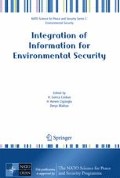Information Technology (GIS, Remote Sensing, satellite communication, etc.) can help a in planning and implementation of hazards reduction measures.
This paper addresses some key aspects regarding integrated use of radar, optical, GPS data over Vrancea seismic area in Romania in order to assess active tectonic of this region. Classifications of different geologic features and Digital Elevation Models (DEM) generation from SAR ERS1/2, Landsat TM, ETM and ASTER data are highly correlated with in-situ ground data. GPS Romanian network stations data revealed a crustal displacement of about 5 or 6 mm/year in horizontal direction relative motion, and a few millimeter/year in vertical direction.
Access this chapter
Tax calculation will be finalised at checkout
Purchases are for personal use only
Preview
Unable to display preview. Download preview PDF.
References
A. G. Gabriel, R. M. Goldstein, H. A. Zebker, Mapping Small Elevation Changes Over Large Areas: Differential Radar Interferometry, J. Geophys. Res., 94, 9183–9191 (1989).
D. Massonnet, M. Rossi, C. Carmona, F. Adragna, G. Peltzer, K. Feigl, T. Rabaute, The Displacement Field of the Landers Earthquake Mapped by Radar Interferometry, Nature, 364, 138–142 (1993).
H. A. Zebker, P. Rosen, R. M. Goldstein, A. Gabriel, C. L. Werner, On the derivation of coseismic displacement fields using differential radar interferometry: The Landers earthquake, J. Geophys. Res., 99, 19617–19634 (1994).
G. Peltzer, P. Rosen, F. Rogez, and K. Hudnut, Poroelastic rebound along the Landers 1992 earthquake surface rupture, J. Geophys. Res., 103, 30, 131–30,145 (1998).
K. S. Pradeep, K. Sandeep, P. S. Ramesh, Neotectonic study of Ganga and Yamuna tear faults, NW Himalaya, using remote sensing and GIS, Int. J. Rem. Sens., 21(3), 499–518 (2000).
S. L. Jutz, J. Chorowicz, Geological mapping and detection of oblique extensional structures in the Kenyan Rife Valley with a SPOT/Landsat-TM data merge, Int. J. Rem. Sens. 14(9), 1677–1688, (1993).
L. Wald, An overview of concepts in fusion of Earth data, Proc. Future Trends in Remote Sensing, A. A. Balkema (Rotterdam, 1998a), pp. 385–390.
L. Wald, Data fusion: a conceptual approach for an efficient exploitation of remote sending images, Proc. Fusion of Earth Data (Sophia Antipolis, France, 1998b), pp. 17–22.
U. Wegmüller and T. Strozzi, Characterization of differential interferometry approaches, EUSAR'98, (Friedrichshafen, Germany, 25–27 May 1998), VDE-Verlag, ISBN 3-8007-2359-X, pp. 237–240.
S. Stramondo et al., The 26 September 1997 Colfiorito, Italy, earthquakes: modeled coseismic surface displacement from SAR interferometry and GPS, Geophys. Res. Lett., 26(7), 883–886 (1 April 1999).
Y. Okada, Surface deformation due to shear and tensile faults in a half space, Bull. Seism. Soc.Am., 75(4), 1135–1154 (August 1985).
K. L. Feigl and E. Duprè, RNGCHN: a program to calculate displacement components from dislocations in an elastic half-space with applications for modeling geodetic measurements of crustal deformation, Computers and Geosciences 25, 695–704, (1999).
S. D. Billings, Simulated annealing for earthquake location, Geophys. J. Int., 118, 680–692, (1994).
P. Lundgren and S. Stramondo, Slip Distribution of the 1997 Umbria-Marche earthquake sequence through joint inversion of GPS and DInSAR data, J. Geophys. Res., B 107(11), 2316, 10.1029/2000JB000103 (November 2002).
Author information
Authors and Affiliations
Corresponding author
Editor information
Editors and Affiliations
Rights and permissions
Copyright information
© 2008 Springer Science+Business Media B.V
About this paper
Cite this paper
Zoran, M. (2008). Integrated Monitoring System For Seismic Risk Assessment In Vrancea Area. In: Coskun, H.G., Cigizoglu, H.K., Maktav, M.D. (eds) Integration of Information for Environmental Security. NATO Science for Peace and Security Series C: Environmental Security. Springer, Dordrecht. https://doi.org/10.1007/978-1-4020-6575-0_21
Download citation
DOI: https://doi.org/10.1007/978-1-4020-6575-0_21
Publisher Name: Springer, Dordrecht
Print ISBN: 978-1-4020-6574-3
Online ISBN: 978-1-4020-6575-0
eBook Packages: Earth and Environmental ScienceEarth and Environmental Science (R0)

